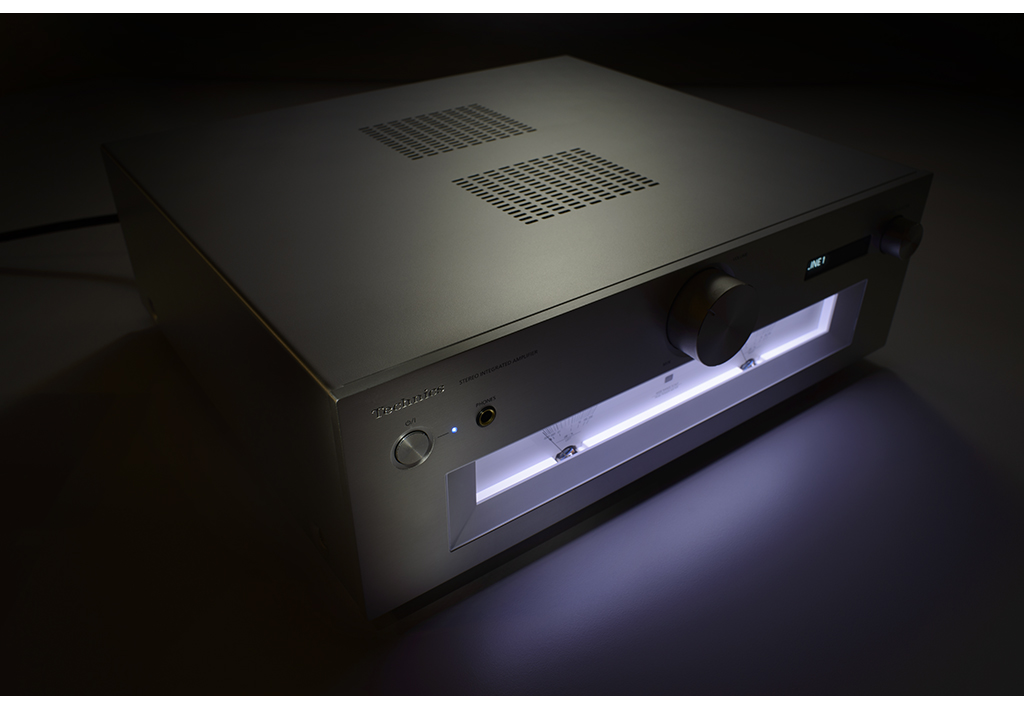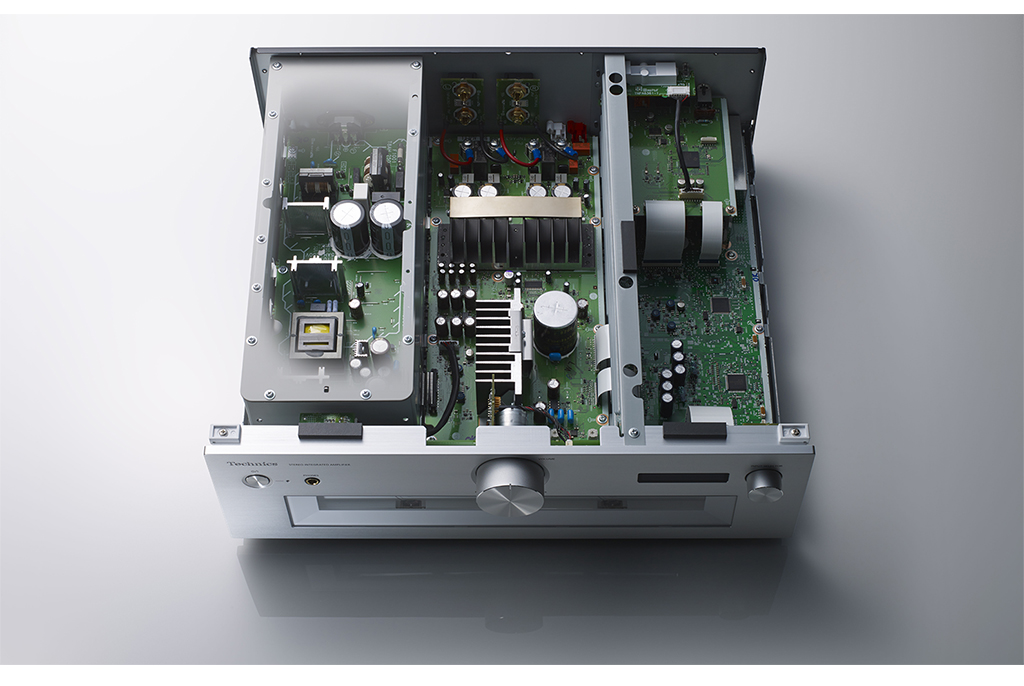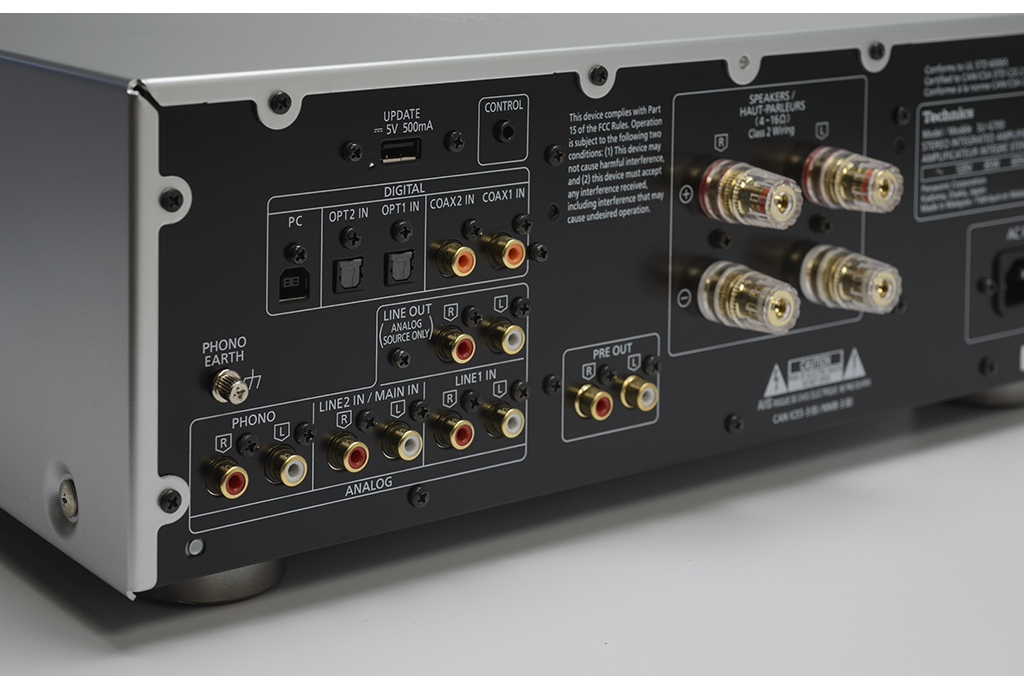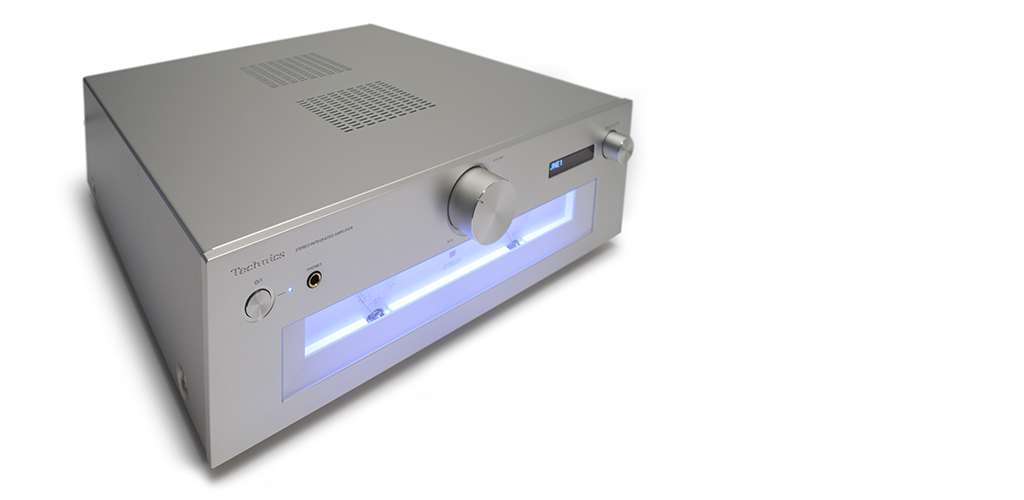Technics SU-G700 Integrated Amplifier Unifying Your Audio Needs
By Jeff Dorgay Watching the power meters bounce in the dark, listening to the title track in Brian Eno’s The Ship, the sheer dynamic power of this compact amplifier is completely revealed.
Watching the power meters bounce in the dark, listening to the title track in Brian Eno’s The Ship, the sheer dynamic power of this compact amplifier is completely revealed.
Eno’s husky voice and deep bass riffs, combined with an atmospheric, ethereal feeling creates an enormous sound field with the Sonus Faber Maxima Amators in the listening room. With even moderately efficient speakers, the 70 watts per channel this amplifier provides is more than enough to partake in realistic listening levels.
The SU-G700s compact, elegant and simple enclosure houses a 70 wpc (into 8 ohms / 140 into 4 ohms) amplifier, but digital is done with a twist. This being a full digital amplifier, there is actually no digital to analog conversion being done until the very last output stage to the loudspeakers, all digital signals (PCM/PWM) remain digital until that point, so no DAC is being done until then. This is what is different about Technics’ digital amplifier design and you still gain the benefit of the higher quality digital processing that a DAC would have given as a result of the 32/384 digital amplifier process throughout. There is an MM phono input for analog lovers too, did you think the makers of the mighty SL-1200 would forget the phono input? For a music lover wanting the ability to access multiple sources with a minimum of clutter, this $2,495 amplifier is going to be tough to beat. The only thing not available is a network streamer. However, it’s easy enough to add your streamer of choice, or use a computer via USB. I’ve beat this topic to death, having the ability to stream without buying another box would be a welcome addition, but not a deal breaker.
It’s often said that talented people make complex tasks look easy, as if anyone could do it. The same can be said for the world’s finest audio components. The level of sound quality, and meticulous attention to build is practically unheard of at this point, showing what having the manufacturing capabilities of a massive company like Technics brings to the table. The SU-G700 feels a lot more like it came from Nagra or Boulder. All of their current products are built to the same standard, think about it – how many SL-1200s are still spinning records 40-plus years later?
Music or tech?
As a tribute to the Technics engineers, there’s a lot going on inside this box. It is a credit to their talent that this is no mere chip amp, or basic A/B amplifier, especially for this price. This amplifier is built like a ten-thousand dollar amplifier, albeit a little different than what a lot of you might be used to. The SU-G700 is a digital amplifier. Digital sources stay in the digital domain all the way through, while analog sources are converted to 24-bit/192kHz digital by a Burr-Brown 1804 A/D converter. Keep in mind that anything connected to one of the two analog inputs (including phono) is also converted to digital.
Using Technics Jitter Elimination and Noise-shaping Optimization (or JENO for short) and a Pulse Width Modulation system, musical signals are amplified in the digital domain and then converted back to analog at the very end before delivering the goods to your speakers. The headphone amplifier uses similar technology to power your favorite headphones.
One of the most interesting aspects of the SU-G700 is its Load Adaptive Phase Calibration (LAPC) circuit, which helps optimize the amplifiers’ output characteristic to match whatever speakers are connected for optimum signal transfer. If you’ve had any experience with Class-D amplifiers, you already know how speaker sensitive they are, and anything presenting a fairly complex load at the speaker terminals doesn’t always produce great results. Not unlike that of an SET tube amplifier. Thanks to Technics proprietary design, the SU-G700 does not have this problem at all, and easily drove all the speakers we had on hand.
Where Devialet has tried something similar with their SAM correction, Technics has done a fantastic job with LAPC – much like earlier ABS braking systems in cars, the Technics system is far less intrusive and produces good result. You merely need to engage the LAPC calibration from the remote (yeah, don’t lose the remote!) and let it do its thing. LAPC runs a few minutes worth of test tones to optimize it for your speakers. Unlike a HT receiver doing “room correction,” (no microphone is required for LAPC) the GU-G700 is internally measuring the load your speakers present to the amplifier and optimizing it for optimum power delivery and phase response.
Where the Devialet system was hit and miss with the test speakers we tried, Technics’ approach provides a more subtle, and at the same time less intrusive result. On everything from a pair of LS3/5A mini monitors all the way up to the Focal Stella Utopia EMs, things sounded better after running the LAPC correction routine. High frequencies always sounded more natural, and in our room, with the speakers at our disposal, low frequencies always felt more powerful, with less upper bass fatigue. Considering this all happening in the context of a $2,500 amplifier is astonishing.
This is only a slight overview of everything inside the SU-G700. Please visit the Technics site here, to get the full description, complete with charts and graphs.
How to interpret the SU-G700
This is one of those interesting pieces of gear that should appeal to both sides of your brain. Your left brain will love all the latest, state of the art tech inside, and the novel approaches taken to implement it. Your right brain will love how great it sounds and how cool it looks. How can that be a bad thing?
Using the onboard digital inputs proved excellent, and for most users that will probably be enough. We did have the Technics SL-G700 SACD player, which ultimately provides a step up in digital decoding (It is $2,999after all) but going from digital to analog and back again through the SU-G700 seemed redundant. Three different transports were used, a vintage SONY ES player, via optical output, the Cambridge CXT (also in this issue) via SPDIF and just to see where the end of the performance envelope was, the dCS Vivaldi One’s digital output. All discs were standard resolution (16/44) CDs.
There definitely was a jump in clarity when using the dCS, no doubt due to less jitter and artifacts in the digital bitstream from this transport, but suffice to say, the vintage and budget players did a great job, so if you have an older CD player or transport, you can expect excellent results. The majority of the evaluation was done with a combination of 16/44 and higher resolution files from Tidal and Qobuz. The Technics does not unfold MQA files.
The SU-G700 has a very neutral, non – embellishing sound quality about it. You will not mistake it for a tube amplifier, or even a pure class-A solid state amplifier, but it is not harsh. Some system matching will be required, as if you have speakers that start out revealing, with a slightly forward tonal balance, like a pair of newer Paradigm speakers, or the incredible Acora Acoustics monitors we have in for review, the Technics might be too much for you. Arguably, my personal bias tends more to a slightly warmer sound like you might experience with Sonus faber, Vandersteen, or Harbeth speakers – so that was my happy place. Almost like pairing a tube preamplifier with a solid-state power amplifier kind of thing.
Regardless of program material used, the SU-G700 offers a consistent presentation. The only characteristic it shares with other digital amplifiers we’ve auditioned is a slight lack of depth compared to your favorite tube gear. Left to right sizing is big, going somewhat beyond the speaker boundaries, but not massive. This overall character really did not change from speaker to speaker, again suggesting what a great job LAPC does.
The MM phono stage offers four gain settings (0, -3, -6, and -10dB) which is handy if you happen to have a Rega cartridge or a few others with higher outputs in the 5-7mv level. Then, the signal is sent to the ADC and treated as sound from any other input. Utilizing a vintage Technics SL-1200 with Shure M44 and a Rega P3 with an Exact II cartridge, both worked well, and the SU-G700 did an excellent job playing records. The resulting sound is dynamic, and incredibly quiet, something that jumps right out at the listener. There is also a switchable subsonic filter from the menu, which will help those of you having speakers with major LF output.
Soundstage width is to the edge of the speakers, not a broad expansive thing that you might expect with your favorite tube phono preamplifier, but then you have to pull yourself back to Earth and realize that this is part of an integrated that only costs $2,500, so in comparison to what’s out there for a few hundred dollars, this is a winner, indeed. The only thing you will notice, is that some of the personality, or some might say, the imperfections of the analog process are somewhat homogenized by the digital nature of the SU-G700.
Overall winner
The SU-G700 has no negatives, and we haven’t even discussed the beautiful enclosure and attention to detail that goes along with this product. From the thick front panel, to the delicately lit power meters and even the high quality of the silk screening on the meters is in five-figure product execution range. If you are a build/style junkie, you’ll freak out by the level of overall quality present here. This is one beautiful piece of hifi gear – and it’s also available in black.
What the Technics SU-G700 does is provide you with a top-notch anchor for a great music system at an incredibly affordable price. It sounds great, looks fantastic, and offers an intuitive user interface too. Good as the remote is, the quality and feel of the controls just beg you to walk up to it, give the volume control a bit of a spin, and watch those power output meters come to life. Pairing it up with the SL-G700 and the speakers of your choice make for an incredibly high value proposition.






